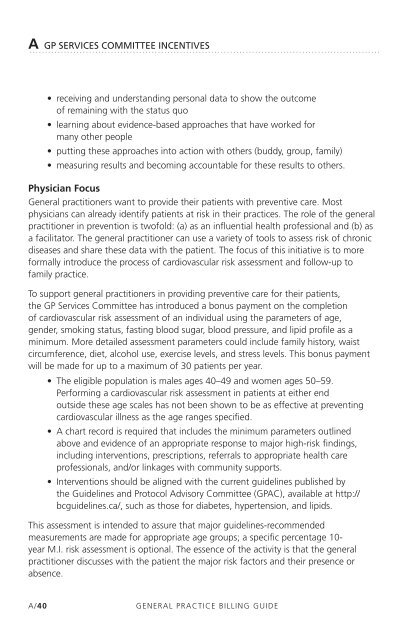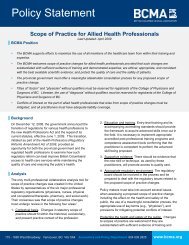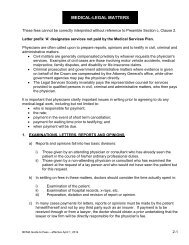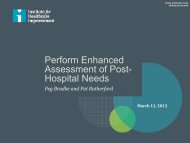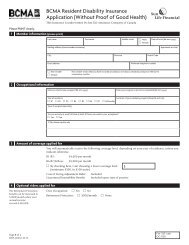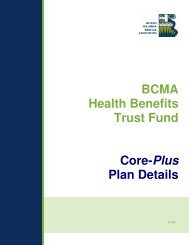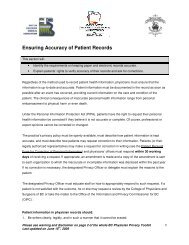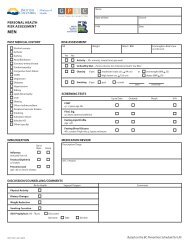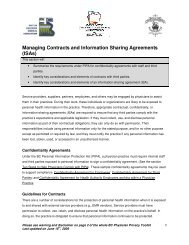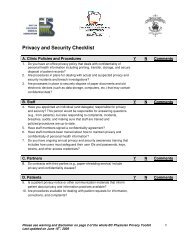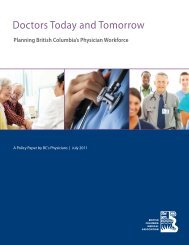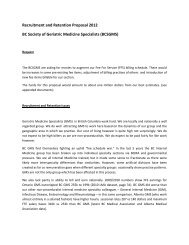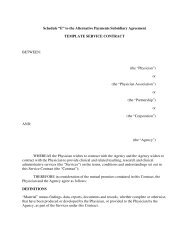General Practice BILLING GUIDE - British Columbia Medical ...
General Practice BILLING GUIDE - British Columbia Medical ...
General Practice BILLING GUIDE - British Columbia Medical ...
You also want an ePaper? Increase the reach of your titles
YUMPU automatically turns print PDFs into web optimized ePapers that Google loves.
A GP SERVICES COMMITTEE INCENTIVES<br />
• receiving and understanding personal data to show the outcome<br />
of remaining with the status quo<br />
• learning about evidence-based approaches that have worked for<br />
many other people<br />
• putting these approaches into action with others (buddy, group, family)<br />
• measuring results and becoming accountable for these results to others.<br />
Physician Focus<br />
<strong>General</strong> practitioners want to provide their patients with preventive care. Most<br />
physicians can already identify patients at risk in their practices. The role of the general<br />
practitioner in prevention is twofold: (a) as an influential health professional and (b) as<br />
a facilitator. The general practitioner can use a variety of tools to assess risk of chronic<br />
diseases and share these data with the patient. The focus of this initiative is to more<br />
formally introduce the process of cardiovascular risk assessment and follow-up to<br />
family practice.<br />
To support general practitioners in providing preventive care for their patients,<br />
the GP Services Committee has introduced a bonus payment on the completion<br />
of cardiovascular risk assessment of an individual using the parameters of age,<br />
gender, smoking status, fasting blood sugar, blood pressure, and lipid profile as a<br />
minimum. More detailed assessment parameters could include family history, waist<br />
circumference, diet, alcohol use, exercise levels, and stress levels. This bonus payment<br />
will be made for up to a maximum of 30 patients per year.<br />
• The eligible population is males ages 40–49 and women ages 50–59.<br />
Performing a cardiovascular risk assessment in patients at either end<br />
outside these age scales has not been shown to be as effective at preventing<br />
cardiovascular illness as the age ranges specified.<br />
• A chart record is required that includes the minimum parameters outlined<br />
above and evidence of an appropriate response to major high-risk findings,<br />
including interventions, prescriptions, referrals to appropriate health care<br />
professionals, and/or linkages with community supports.<br />
• Interventions should be aligned with the current guidelines published by<br />
the Guidelines and Protocol Advisory Committee (GPAC), available at http://<br />
bcguidelines.ca/, such as those for diabetes, hypertension, and lipids.<br />
This assessment is intended to assure that major guidelines-recommended<br />
measurements are made for appropriate age groups; a specific percentage 10year<br />
M.I. risk assessment is optional. The essence of the activity is that the general<br />
practitioner discusses with the patient the major risk factors and their presence or<br />
absence.<br />
A/40<br />
GENERAL PRACTICE <strong>BILLING</strong> <strong>GUIDE</strong>


